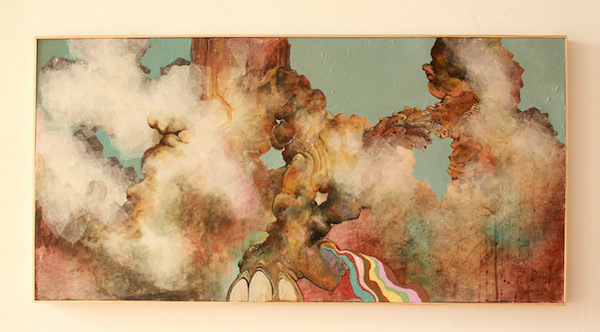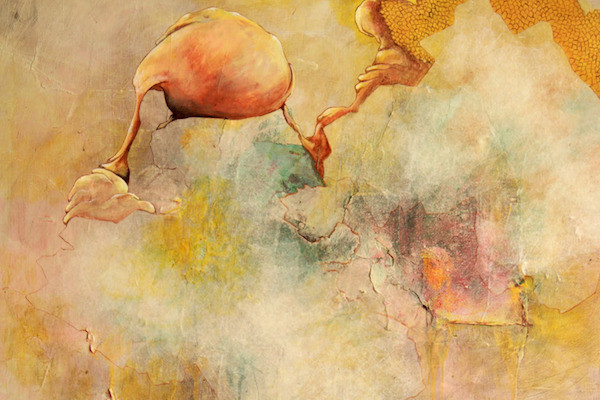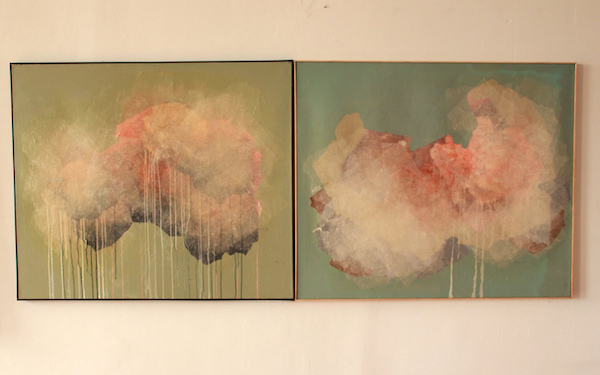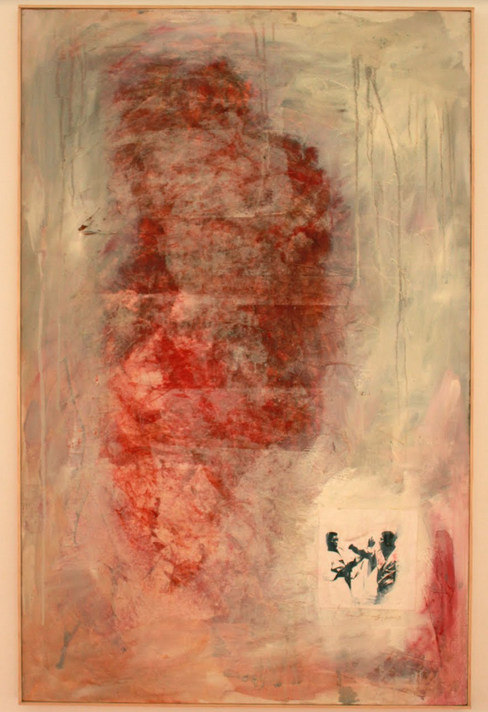[Evan reviews a show of old and new work by artist Eric Kennedy, and examines the direction in which Kennedy seems to be heading. — the Artblog editors]
COLLAGE, a solo exhibition by Eric Kennedy at Pterodactyl Philadelphia, is a showcase of the artist’s explorations in very basic visual elements–texture, form, and color. To label the pieces themselves as basic would not be fitting, however, as Kennedy at his best achieves a remarkable degree of subtlety and depth.
Intricate textures beg a closer look

These works exist in Pterodactyl in a somewhat cluttered and disjointed fashion–most likely thanks to the space the gallery shares with Fireball Printing, its partner company. It is clearly a well-used and well-trafficked area, which actually makes stopping to assess the intricacies of the paintings more rewarding, even if some of the paintings appeared to be knocked off-kilter.
Most of Kennedy’s larger works are hung in succession on two adjacent walls; these are his earlier and perhaps more directed studies in the basic elements of his aesthetic, circa 2005. On the central island and surrounding smaller walls hangs his more recent work from the past few years, which takes drastically different directions in size and the inclusion of discernable imagery.

Kennedy’s works are of the sort that can only truly be understood in person. Layers of paint and wax paper recede and protrude ever so slightly, revealing and concealing further layers of the same materials.
As the layers in the works evolve organically, so does a fascinatingly minute textural landscape–the translucent material appearing almost like skin peeling after a sunburn, begging to be picked off. This rough-and-smooth pattern is further accentuated by the raw canvas that serves as substrate, which gives way to the plasticky evenness of the wax paper: a material that seems organic despite being completely synthetic. The term “collage” is a blanket one, and possibly the only category into which all of these works would fit.
New, smaller works

There are traces of line in pattern in a few of these earlier works–graphite marks, or what looks like a tire track, for instance, that hint at Kennedy’smore recent endeavors. But the most noticeable difference between these two sets of pieces is size.
Rather than being mostly uniform and large, the newer works tend to be much smaller and created on longer canvases. Despite their smaller scale, these works actually have much busier compositions. Kennedy begins to paint more defined forms and shapes, in solid colors and with the inclusion of linework. There is an atmospheric, implied geography in these works, too, as the textures appear more and more like mountains or hills, and the wax paper takes on the look of a cloud. Now, these basic elements no longer exist outside of the realm of association.

The word “collage” often implies sourced imagery, and in a few of Kennedy’s works, sourced or appropriated material does appear. Magazine clippings and photographs are adhered to some works, but I mostly found them distracting. In addition, a few works have female forms and faces drawn in mirrored fashion, facing one another. Maybe Kennedy is trying to draw a connection between the forms in his paintings and the form of the body, but the hand-drawn additions end up seeming cluttered and forced.
If Kennedy is to continue with his work in collage, which I hope he does, it should be with his eye fixed on the focused abstraction of his earlier pieces; the avoidance of heavy-handed imagery; and a sophistication of the bolder colors and patterns in his newer work.
COLLAGE (works by Eric Kennedy) is on view at Pterodactyl Philadelphia now through August 22, 2014.









